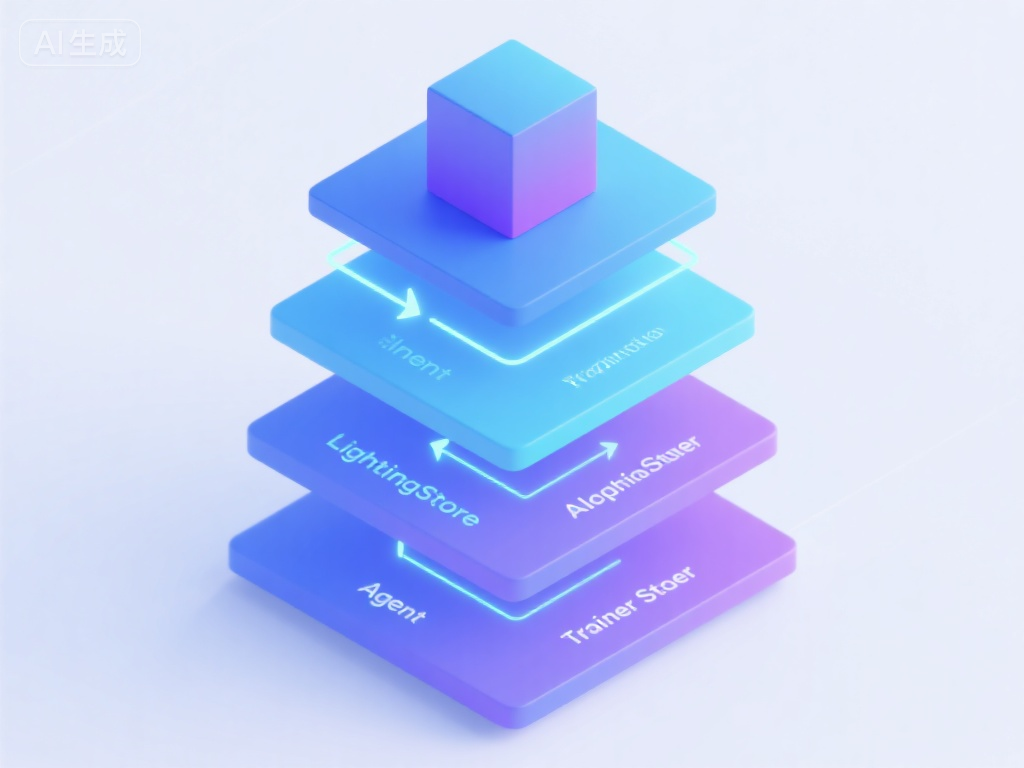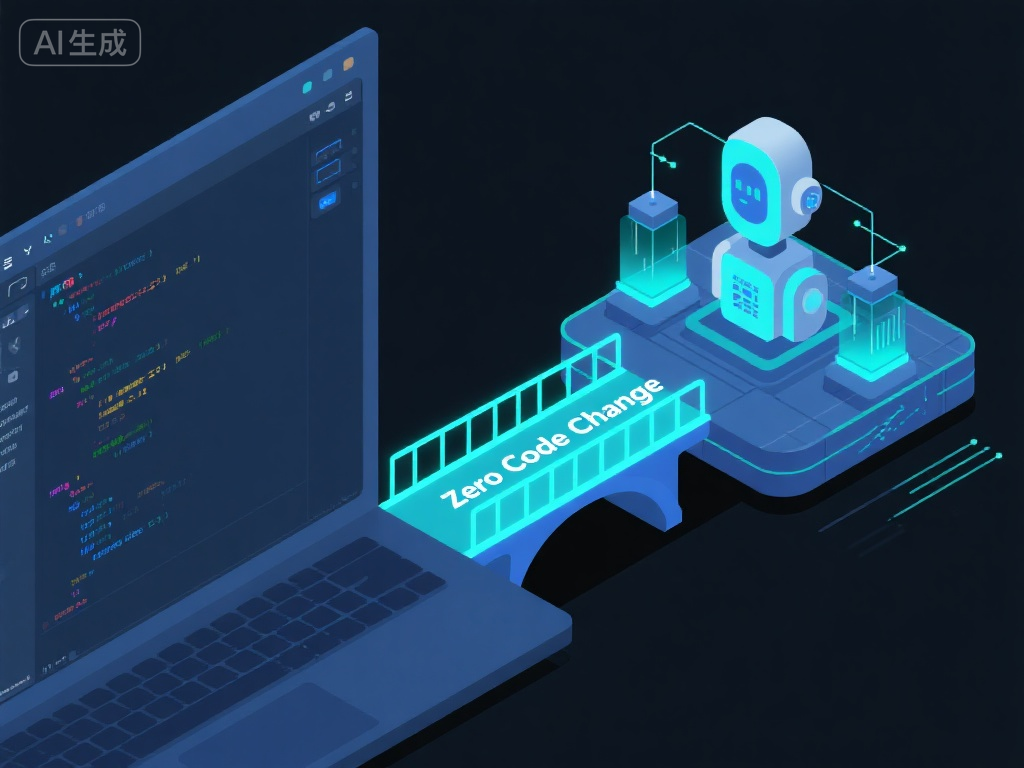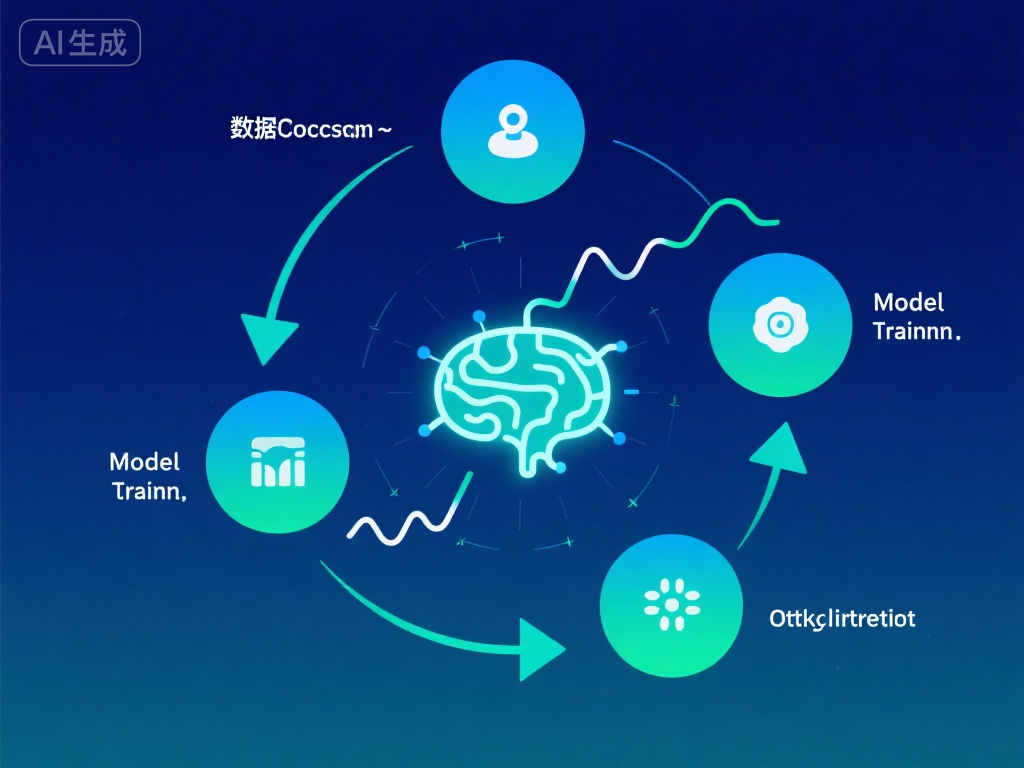引言 在 AI 智能体(Agent)开发领域,训练和优化一直是一个充满挑战的环节。开发者常常面临这样的困境:要么花费大量时间重构代码以适应训练框架,要么被特定框架深度绑定,失去灵活性。微软研究院推出的 Agent Lightning (智能体闪电)框架,正是为了解决这些痛点而生。
Agent Lightning 是一个开源的 AI 智能体训练框架,它的核心理念是:让智能体优化变得像安装一个插件一样简单 。通过几乎零代码改动,你就能为现有的智能体添加强化学习、自动提示词优化或监督微调能力。无论你使用的是 LangChain、OpenAI Agent SDK、AutoGen、CrewAI,还是自己编写的 Python 代码,Agent Lightning 都能无缝集成。
本文将深入探讨 Agent Lightning 的架构设计、核心功能、实际应用场景以及最佳实践,帮助你快速掌握这个强大的工具。
项目概览 基本信息
核心特性 Agent Lightning 的设计哲学可以用一句话概括:“无需重写,无需绑定,只需一条从初次部署到持续改进的清晰路径” 。具体来说,它提供了以下核心能力:
graph TB
A[Agent Lightning 核心特性] --> B[零代码集成]
A --> C[框架无关性]
A --> D[选择性优化]
A --> E[算法灵活性]
B --> B1[轻量级 emit 辅助函数]
B --> B2[自动追踪机制]
C --> C1[LangChain]
C --> C2[OpenAI SDK]
C --> C3[AutoGen]
C --> C4[CrewAI]
C --> C5[自定义实现]
D --> D1[多智能体系统]
D --> D2[针对性训练]
E --> E1[强化学习]
E --> E2[提示词优化]
E --> E3[监督微调]
E --> E4[自定义算法]
架构设计 Agent Lightning 采用了模块化、松耦合的架构设计,确保与现有智能体系统的无缝集成。整个框架由四个核心组件构成:
1. Agent 层(智能体层) 这是你现有的智能体代码所在的层级。Agent Lightning 的设计原则是最小化侵入性 ,你只需要在关键位置添加轻量级的追踪代码:
1 2 3 4 5 6 7 8 9 10 import agentlightning as aglagl.emit_action("user_query" , query_text) agl.emit_observation("api_response" , response_data) agl.emit_reward("task_success" , score) with agl.auto_trace(): agent.run(task)
2. LightningStore(数据中枢) LightningStore 是整个系统的神经中枢,负责:
任务管理 :协调训练任务和推理任务资源同步 :管理提示词、策略权重等可训练资源执行追踪 :记录智能体的每一步操作(spans)数据流转 :在智能体、训练算法和推理引擎之间传递信息
graph LR
A[Agent 执行] -->|emit spans| B[LightningStore]
B -->|提供训练数据| C[Training Algorithm]
C -->|优化后的资源| B
B -->|更新资源| D[Inference Engine]
D -->|驱动 Agent| A
3. Training Algorithm(训练算法) 这一层实现了各种智能体优化算法,包括:
强化学习(RL) :通过奖励信号优化智能体行为自动提示词优化(APO) :自动改进系统提示词和少样本示例监督微调(SFT) :基于标注数据微调模型参数自定义算法 :支持用户实现专有的训练策略
算法从 LightningStore 读取执行轨迹(spans),分析智能体行为,生成改进建议(如优化后的提示词、更新的权重),然后回写到 Store 中。
4. Trainer(训练编排器) Trainer 是整个训练流程的指挥官,职责包括:
数据流管理 :从 Store 获取训练数据集并流式传输给算法资源协调 :管理训练资源(GPU/CPU)的分配版本控制 :协调不同版本的模型和提示词推理引擎更新 :将训练成果部署到生产环境
完整架构流程 sequenceDiagram
participant A as Agent
participant S as LightningStore
participant T as Trainer
participant Alg as Algorithm
participant I as Inference Engine
A->>S: emit_action/observation/reward
S->>S: 存储 execution spans
T->>S: 请求训练数据
S->>T: 返回 span 数据集
T->>Alg: 传递训练数据
Alg->>Alg: 分析并生成优化建议
Alg->>T: 返回优化后的资源
T->>S: 更新资源版本
S->>I: 同步最新资源
I->>A: 使用优化后的资源执行任务
快速开始 安装 使用 pip 即可完成安装:
1 pip install agentlightning
最小化集成示例 假设你有一个简单的 OpenAI 智能体:
1 2 3 4 5 6 7 8 9 10 11 12 13 14 15 16 17 18 19 20 21 22 23 24 25 26 27 28 29 from openai import OpenAIimport agentlightning as aglclient = OpenAI() def simple_agent (user_query ): response = client.chat.completions.create( model="gpt-4" , messages=[ {"role" : "system" , "content" : "You are a helpful assistant." }, {"role" : "user" , "content" : user_query} ] ) agl.emit_action("user_query" , user_query) agl.emit_observation("llm_response" , response.choices[0 ].message.content) agl.emit_reward("success" , 1.0 if response else 0.0 ) return response.choices[0 ].message.content store = agl.LightningStore(backend="local" ) with agl.context(store=store): result = simple_agent("What is reinforcement learning?" ) print (result)
启动训练 收集足够的执行数据后,就可以启动训练流程:
1 2 3 4 5 6 7 8 9 10 11 12 13 14 15 16 17 from agentlightning.algorithms import APO trainer = agl.Trainer( store=store, algorithm=APO( model="gpt-4" , optimization_target="system_prompt" ), max_iterations=10 ) trainer.train()
核心功能详解
1. 零代码集成能力 Agent Lightning 提供了两种集成方式:
手动标记模式 在关键位置添加 agl.emit_xxx() 函数:
1 2 3 4 5 6 7 8 agl.emit_action("api_call" , {"endpoint" : "/users" , "method" : "GET" }) agl.emit_observation("api_response" , {"status" : 200 , "data" : users}) agl.emit_reward("task_completion" , score=0.95 )
自动追踪模式 使用装饰器或上下文管理器实现零代码改动:
1 2 3 4 5 6 7 8 9 @agl.auto_trace() def my_agent_function (task ): return agent.execute(task) with agl.auto_trace(): agent.run_task()
2. 框架无关性 Agent Lightning 的兼容性列表:
框架
集成方式
代码改动
LangChain 内置追踪器
~5 行
OpenAI Agent SDK 装饰器
~3 行
AutoGen 回调函数
~8 行
CrewAI 中间件
~6 行
自定义实现 手动标记
~10-15 行
示例:集成 LangChain
1 2 3 4 5 6 7 8 9 10 11 12 13 from langchain.agents import initialize_agentfrom langchain.tools import Toolimport agentlightning as agltools = [Tool(name="Search" , func=search_function)] agent = initialize_agent(tools, llm, agent_type="zero-shot-react-description" ) agent = agl.wrap_langchain(agent, store=store) agent.run("Find the latest AI research papers" )
3. 选择性优化 在多智能体系统中,可以精确控制哪些智能体参与训练:
1 2 3 4 5 6 7 8 9 10 11 12 13 14 15 16 class MultiAgentSystem : def __init__ (self ): self .planner = PlannerAgent() self .executor = ExecutorAgent() self .reviewer = ReviewerAgent() def run (self, task ): with agl.context(store=store, track_only=["planner" ]): plan = self .planner.create_plan(task) result = self .executor.execute(plan) review = self .reviewer.review(result) return result
4. 多样化训练算法
强化学习(RL) 通过奖励信号优化智能体决策:
1 2 3 4 5 6 7 8 9 10 from agentlightning.algorithms import PPOtrainer = agl.Trainer( store=store, algorithm=PPO( learning_rate=3e-4 , gamma=0.99 , batch_size=64 ) )
自动提示词优化(APO) 自动改进系统提示词以提升性能:
1 2 3 4 5 6 7 8 9 10 from agentlightning.algorithms import APOtrainer = agl.Trainer( store=store, algorithm=APO( model="gpt-4" , evaluation_metric="task_success_rate" , num_candidates=5 ) )
监督微调(SFT) 基于高质量示例数据微调模型:
1 2 3 4 5 6 7 8 9 10 from agentlightning.algorithms import SupervisedFineTuningtrainer = agl.Trainer( store=store, algorithm=SupervisedFineTuning( base_model="llama-3-8b" , epochs=3 , learning_rate=2e-5 ) )
实际应用场景 场景 1:SQL 智能体优化 假设你开发了一个将自然语言转换为 SQL 查询的智能体:
1 2 3 4 5 6 7 8 9 10 11 12 13 14 15 16 17 18 19 20 21 22 23 24 25 26 27 28 29 30 31 32 33 34 35 36 37 38 39 40 41 42 43 44 45 46 47 48 49 50 51 52 53 54 55 56 57 import agentlightning as aglclass SQLAgent : def __init__ (self ): self .llm = OpenAI() self .prompt = """You are a SQL expert. Convert user questions to SQL queries. Examples: - "Show all users" → SELECT * FROM users; - "Count active orders" → SELECT COUNT(*) FROM orders WHERE status='active'; """ def query (self, user_question ): agl.emit_action("user_question" , user_question) sql = self .llm.chat.completions.create( model="gpt-4" , messages=[ {"role" : "system" , "content" : self .prompt}, {"role" : "user" , "content" : user_question} ] ) agl.emit_observation("generated_sql" , sql.choices[0 ].message.content) try : result = execute_sql(sql) reward = 1.0 agl.emit_reward("execution_success" , reward) except Exception as e: reward = 0.0 agl.emit_reward("execution_success" , reward) agl.emit_observation("error" , str (e)) return result store = agl.LightningStore() agent = SQLAgent() with agl.context(store=store): for question in test_questions: agent.query(question) trainer = agl.Trainer( store=store, algorithm=APO(optimization_target="system_prompt" ) ) trainer.train()
场景 2:客服智能体强化学习 优化客服对话流程:
1 2 3 4 5 6 7 8 9 10 11 12 13 14 15 16 17 18 19 20 21 22 23 24 25 26 27 28 29 30 31 32 33 34 35 36 37 38 39 40 class CustomerServiceAgent : def __init__ (self ): self .conversation_history = [] def handle_request (self, user_message ): agl.emit_action("user_message" , user_message) intent = self .classify_intent(user_message) agl.emit_observation("intent" , intent) response = self .generate_response(intent, user_message) agl.emit_action("bot_response" , response) feedback = self .get_user_feedback() reward = self .calculate_reward(feedback) agl.emit_reward("user_satisfaction" , reward) return response def calculate_reward (self, feedback ): score = 0.0 if feedback["resolved" ]: score += 0.5 if feedback["satisfaction" ] >= 4 : score += 0.3 if feedback["response_time" ] < 60 : score += 0.2 return score trainer = agl.Trainer( store=store, algorithm=PPO( learning_rate=1e-4 , reward_shaping=True ), max_iterations=1000 ) trainer.train()
场景 3:多智能体协作优化 在一个研究助手系统中,只优化文献检索智能体:
1 2 3 4 5 6 7 8 9 10 11 12 13 14 15 16 17 18 19 20 21 22 class ResearchAssistant : def __init__ (self ): self .retriever = RetrieverAgent() self .summarizer = SummarizerAgent() self .writer = WriterAgent() def research_topic (self, topic ): with agl.context(store=store, track_only=["retriever" ]): papers = self .retriever.find_papers(topic) summary = self .summarizer.summarize(papers) report = self .writer.write_report(summary) return report trainer = agl.Trainer( store=store, algorithm=APO(optimization_target="retriever.search_strategy" ) ) trainer.train()
高级特性 1. 并行化训练 Agent Lightning 支持数据并行和模型并行:
1 2 3 4 5 6 7 8 9 trainer = agl.Trainer( store=store, algorithm=PPO(), parallelization=agl.ParallelConfig( num_workers=4 , distributed_backend="nccl" , gradient_accumulation_steps=4 ) )
2. 调试与可视化 内置丰富的调试工具:
1 2 3 4 5 6 7 8 9 10 11 12 13 14 15 agl.set_debug_mode(True ) from agentlightning.visualization import plot_training_metricsplot_training_metrics( store=store, metrics=["reward" , "loss" , "success_rate" ], save_path="training_curves.png" ) tracer = agl.Tracer(store=store) tracer.analyze_episode(episode_id="ep_123" )
3. 解决 Retokenization Drift Agent Lightning 团队在 2025年10月发现了 OpenAI 兼容 API 中的 “retokenization drift” 问题,并提供了解决方案:
1 2 3 4 5 6 7 8 from agentlightning.fixes import enable_retokenization_fixtrainer = agl.Trainer( store=store, algorithm=PPO(), fixes=[enable_retokenization_fix()] )
这个修复显著提升了使用 OpenAI API 进行强化学习训练时的稳定性和收敛速度。
4. 自定义算法 可以继承基类实现专有训练逻辑:
1 2 3 4 5 6 7 8 9 10 11 12 13 14 15 16 17 18 19 20 21 22 from agentlightning.algorithms import BaseAlgorithmclass CustomOptimizer (BaseAlgorithm ): def __init__ (self, my_param ): super ().__init__() self .my_param = my_param def train_step (self, batch ): spans = batch["spans" ] rewards = batch["rewards" ] optimized_resource = self .my_optimization_logic(spans, rewards) return {"resource_update" : optimized_resource} trainer = agl.Trainer( store=store, algorithm=CustomOptimizer(my_param=0.5 ) )
性能与最佳实践 性能优化建议
批量处理 :累积一定数量的 spans 后再启动训练
1 2 3 4 5 trainer = agl.Trainer( store=store, algorithm=PPO(), min_batch_size=1000 )
异步数据收集 :生产环境中将数据收集与训练分离
1 2 3 4 5 6 7 with agl.context(store=remote_store): agent.run_production_tasks() trainer = agl.Trainer(store=remote_store) trainer.train_async()
增量训练 :避免从头训练
1 trainer.resume_from_checkpoint("checkpoint_epoch_10.pt" )
最佳实践清单
数据质量优先 :确保奖励信号准确反映任务目标渐进式部署 :先在小规模测试集上验证训练效果版本管理 :为每个训练版本打标签,便于回滚监控指标 :持续监控生产环境中的智能体性能A/B 测试 :对比训练前后的性能差异
1 2 3 4 5 6 7 8 9 10 11 12 13 14 15 16 17 18 19 20 21 22 23 24 25 26 27 28 29 30 class ProductionPipeline : def __init__ (self ): self .store = agl.LightningStore(backend="redis" ) self .trainer = agl.Trainer(store=self .store) def collect_phase (self, duration_hours=24 ): """数据收集阶段""" with agl.context(store=self .store): run_agent_for_duration(duration_hours) def train_phase (self ): """训练阶段""" self .trainer.train() self .trainer.save_checkpoint("latest.pt" ) def evaluate_phase (self ): """评估阶段""" test_metrics = evaluate_on_test_set(self .store) if test_metrics["success_rate" ] > 0.85 : return True return False def deploy_phase (self ): """部署阶段""" if self .evaluate_phase(): deploy_to_production(self .store) log_deployment("version_1.2.3" , metrics) else : rollback_to_previous_version()
社区与生态 社区项目 Agent Lightning 已经催生了一些有趣的社区项目:
DeepWerewolf :基于 Agent Lightning 训练的狼人杀游戏智能体AgentFlow :针对工作流自动化场景的优化实现
学习资源
贡献指南 Agent Lightning 欢迎社区贡献:
1 2 3 4 5 6 7 8 9 10 11 12 13 14 15 git clone https://github.com/microsoft/agent-lightning.git cd agent-lightningpip install -e ".[dev]" pytest tests/
技术对比 Agent Lightning vs. 传统方法
维度
Agent Lightning
传统训练框架
代码改动 ~5-10 行
完全重构
框架绑定 无绑定
深度耦合
学习曲线 1-2 天
1-2 周
训练灵活性 多算法支持
通常单一算法
生产部署 即插即用
需要迁移
多智能体支持 选择性优化
全量训练
适用场景分析 适合使用 Agent Lightning 的场景 :
已有生产环境智能体需要优化
多框架混合的智能体系统
需要快速迭代实验的研究项目
资源有限,无法大规模重构
不太适合的场景 :
从零开始构建且对特定框架有深度依赖
需要极致定制化的训练流程(虽然支持自定义算法,但有一定限制)
未来展望 根据项目路线图和社区讨论,Agent Lightning 未来可能会加入:
更多预置算法 :包括 DPO(Direct Preference Optimization)、RLHF 等分布式训练增强 :支持更大规模的多机训练可视化工具 :更强大的训练过程可视化和调试工具模型市场 :预训练智能体模型的分享平台云原生支持 :与 Azure Machine Learning 等平台的深度集成
总结 Agent Lightning 为 AI 智能体的优化训练带来了一场”闪电式”的革命。它的核心价值在于:
极低的集成成本 :几乎零代码改动就能为现有智能体添加训练能力框架无关性 :不被任何特定框架绑定,保持技术栈的灵活性选择性优化 :在多智能体系统中精确控制优化目标算法多样性 :从强化学习到提示词优化,满足不同场景需求生产友好 :从研发到部署的完整工作流支持
无论你是 AI 研究者、智能体开发者,还是产品工程师,Agent Lightning 都值得一试。它不仅能显著提升智能体性能,还能让你保持代码的简洁和架构的灵活。
如果你正在构建智能体系统,或者已有的智能体需要性能提升,不妨从一个简单的实验开始:
1 pip install agentlightning
然后在你的代码中添加几行追踪代码,启动训练,见证智能体的”闪电式”进化。
参考资源
关于作者
本文深入介绍了 Microsoft Agent Lightning 的架构设计、核心功能和实战应用。如果你对 AI 智能体、强化学习或大模型应用感兴趣,欢迎关注后续文章。
许可声明
本文基于 MIT 许可的开源项目 Agent Lightning 编写,内容遵循 CC BY-NC-SA 4.0 协议。



